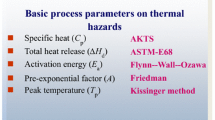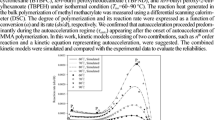Abstract
Acrylic acid is a monomer that has been responsible for a number of severe explosions worldwide as a result of thermal runaway. The present work was intended to lead to an improved understanding of the kinetics of the thermal polymerization and Michael addition reaction (MAR) of acrylic acid. Sealed cell differential scanning calorimetry was carried out, and the kinetics of the thermal polymerization of acrylic acid were assessed on the basis of the model-free Friedman method. In addition, microcalorimetry using a Thermal Activity Monitor IV apparatus was conducted to determine the kinetic parameters for the MAR. The rate constant for the MAR was found to be k (s−1) = 3.45 × 105 × exp (− 9.48 × 103/T (K)), while the activation energy was 78.8 kJ mol−1. The progress of the MAR was fitted with an n-order reaction model, and the reaction order as well as the rate constant was determined to be linearly proportional to temperature. By employing a modified n-order reaction model in which the reaction order was a linear function of temperature, we obtained a reaction rate equation for the MAR that closely reproduced the experimental results over a wide temperature range.












Similar content being viewed by others
Abbreviations
- A :
-
Pre-exponential factor (s−1)
- B :
-
Baseline signal for heat flow in calorimetry (W g−1)
- E a :
-
Activation energy (kJ mol−1)
- f(α):
-
Reaction model (–)
- K :
-
Reaction rate constant (s−1)
- N :
-
Reaction order (–)
- R :
-
Gas constant (J mol−1 K−1)
- S :
-
Heat flow signal in calorimetry (W g−1)
- T :
-
Time (s or min or h)
- t α :
-
Time at which the reaction progress is α (s)
- T :
-
Temperature (°C or K)
- T 0 :
-
Initial temperature (°C or K)
- T f :
-
Final temperature (°C or K)
- α :
-
Reaction progress, conversion (–)
References
Fujita M, Izato Y, Iizuka Y, Miyake A. Thermal hazard evaluation of runaway polymerization of acrylic acid. Process Saf Environ Prot. 2019;129:339–47.
Center for Chemical Process Safety (CCPS). Guidelines for safe storage and handling of reactive materials. New York: American Institute of Chemical Engineers; 1995.
Levy LB, Penrod JD. The anatomy of an acrylic acid runaway polymerization. Plant Oper Prog. 1989;8:105–8.
Nippon Shokubai Co., Ltd. Himeji plant explosion and fire at acrylic acid production facility investigation report. Nippon Shokubai Co., Ltd. Japan. 2013. https://www.shokubai.co.jp/en/news/file.cgi?file=file1_0071.pdf of subordinate document. Accessed 22 Apr 2020.
Kao C, Hu K. Acrylic reactor runaway and explosion accident analysis. J Loss Prev Proc Ind. 2002;15:213–22.
Kalfas G, Krieger T, Wilcox R. Improvements in the safety screening of resin manufacturing processes. Proc Safe Prog. 2009;28:275–81.
Gromacki M. Acrylic polymer reactor accident investigation: Lessons learned and three years later. In: CCPS international conference and workshop on process industry incidents. USA; 2000.
Kurland JJ, Bryant DR. Shipboard polymerization of acrylic acid. Plant Oper Prog. 1987;6:203–7.
Gustin JL. How the study of accident case histories can prevent runaway reaction accidents from recurring. Inst Chem Eng. 2002;80:16–24.
Wang C, Chang C, Tseng J. Epoxy acrylic resin experimental analysis of runaway reaction. J Therm Anal Calorim. 2019;138:2839–51.
Fujita M, Iizuka Y, Miyake A. Thermal and kinetic analyses on Michael addition reaction of acrylic acid. J Therm Anal Calorim. 2017;128:1227–33.
Sun Q, Jiang L, Li M, Sun J. Assessment on thermal hazards of reactive chemicals in industry: state of the art and perspectives. Prog Energy Combust Sci. 2020. https://doi.org/10.1016/j.pecs.2020.100832.
UN Model Regulations. United Nations Recommendations on the transport of dangerous goods—model regulations, 19th rev. New York, Geneva: United Nations; 2015.
Sheng M, Dan F, Horsch S, Bellair R, Holsinger M, Scholtz T, Weinberg S, Sopchik A. calorimetric method to determine self-accelerating polymerization temperature (SAPT) for monomer transportation regulation: kinetics and screening criteria. Org Process Res Dev. 2019;23:737–49.
Krause G, Wehrstedt K, Malow M, Budde K, Mosler J. Safe transport of acrylic acid in railroad tank cars, part 1: determination of the self-accelerating decomposition temperature. Chem Eng Technol. 2014;37:1460–7.
Rohm and Haas Company. Storage and handling of acrylic and methacrylic esters and acids. Philadelphia: Rohm and Haas Brochure; 1987.
Basic Acrylic Monomer Manufacturers Inc. Acrylic acid, a summary of safety and handling, 4th ed. Basic Acrylic Monomer Manufacturers Inc. USA 2013. http://msdssearch.dow.com/publishedliteraturedowcom/dh_0933/0901b80380933166.pdf of subordinate document. Accessed 22 Apr 2020.
Torfs JC, Deij L, Dorrepaal AJ, Heijens JC. Determination of Arrhenius kinetic constants by differential scanning calorimetry. Anal Chem. 1984;56:2863–7.
Khoshooei MA, Fazlollahi F, Maham Y. A review on the application of differential scanning calorimetry (DSC) to petroleum products. J Therm Anal Calorim. 2019;138:3455–84.
Kök M, Iscan A. Oil shale kinetics by differential methods. J Therm Anal Calorim. 2007;88:657–61.
Smith KW, Cain FW, Talbot G. Kinetic analysis of nonisothermal differential scanning calorimetry of 1, 3-dipalmitoyl-2-oleoylglycerol. J Agric Food Chem. 2005;53:3031–40.
Vyazovkin S, Burnham AK, Criado JM, Pérez-Maqueda LA, Popescu C, Sbirrazzuoli N. ICTAC Kinetics Committee recommendations for performing kinetic computations on thermal analysis data. Thermochim Acta. 2011;520:1–19.
AKTS. Advanced Kinetics and Technology Solutions. https://www.akts.com of subordinate document. Accessed 22 Apr 2020.
Friedman HL. Kinetics of thermal degradation of char-forming plastics from thermogravimetry. Application to a phenolic plastic. J Polym Sci C. 1963;6:183–95.
Ozawa T. Applicability of Friedman plot. J Therm Anal. 1986;3:547–51.
Bercic G. The universality of Friedman’s isoconversional analysis results in a model-less prediction of thermodegradation profiles. Thermochim Acta. 2017;650:1–7.
Izato Y, Miyake A. Kinetic analysis of the thermal decomposition of liquid ammonium nitrate based on thermal analysis and detailed reaction simulations. J Therm Anal Calorim. 2018;134:813–23.
Mizuta R, Izato Y, Miyake A. Thermal ignition behavior of waste woods mixed with unsaturated fatty acids. J Therm Anal Calorim. 2015;121:361–9.
Yamamoto Y, Miyake A. Influence of a mixed solvent containing ionic liquids on the thermal hazard of the cellulose dissolution process. J Therm Anal Calorim. 2017;27:743–8.
Hartwig A, Brand RH, Pfeifer C, Dürr N, Drochner A, Vogel H. Safety and quality aspects of acrylic monomers. Macromol Symp. 2011;302:280–8.
Levy LB. Inhibition of acrylic acid polymerization by phenothiazine and p-methoxyphenol. II. Catalytic inhibition by phenothiazine. J Polym Sci A Polym Chem. 1992;30:569–76.
Kirch LS, Kargol JA, Magee JW, Stuper WS. Stability of acrylic monomers. Plant Oper Prog. 1988;7:270–4.
Maschio G, Moutier C. Polymerization reactor: the influence of “gel effect” in batch and continuous solution polymerization of methyl methacrylate. J Appl Polym Sci. 1989;37:825–40.
Chiu WY, Carratt GM, Soong DS. A computer model for the gel effect in free-radical polymerization. Macromolecules. 1983;16:348–57.
Verros GD, Achilias DS. Modeling gel effect in branched polymer systems: free-radical solution homopolymerization of vinyl acetate. J Appl Polym Sci. 2009;111:2171–85.
Ding J, Yu L, Wang X, Xu Q, Yang S, Ye S, Jiang J. A kinetic-based approach in accelerating rate calorimetry with the varying thermal inertia consideration. J Therm Anal Calorim. 2019. https://doi.org/10.1007/s10973-019-09081-z.
Acknowledgements
Part of this work was supported by JSPS KAKENHI grant number JP 20J15388, 18KT0012, and the Environment Research and Technology Development Fund (JPMEERF20191004) of the Environmental Restoration and Conservation Agency of Japan.
Author information
Authors and Affiliations
Corresponding author
Additional information
Publisher's Note
Springer Nature remains neutral with regard to jurisdictional claims in published maps and institutional affiliations.
Rights and permissions
About this article
Cite this article
Fujita, M., Izato, Yi. & Miyake, A. Kinetic analysis of the spontaneous thermal polymerization of acrylic acid. J Therm Anal Calorim 144, 435–442 (2021). https://doi.org/10.1007/s10973-020-10534-z
Received:
Accepted:
Published:
Issue Date:
DOI: https://doi.org/10.1007/s10973-020-10534-z




